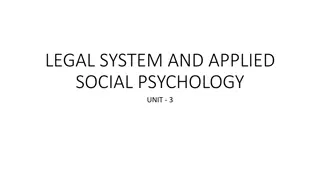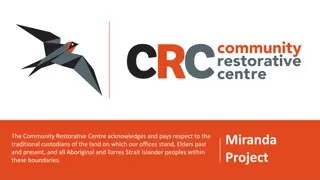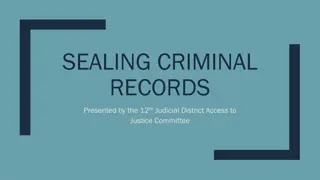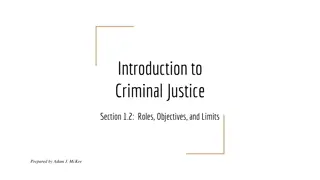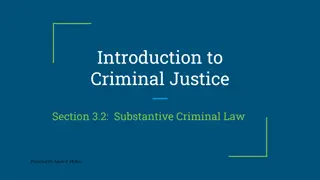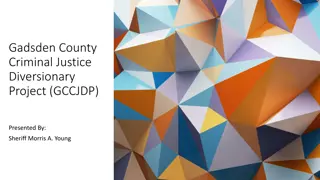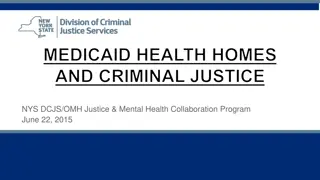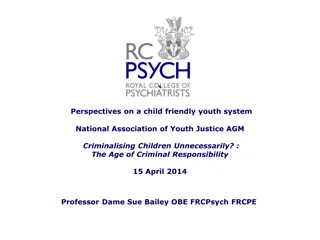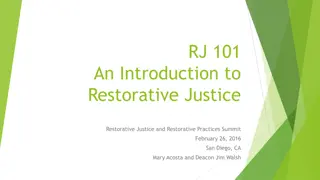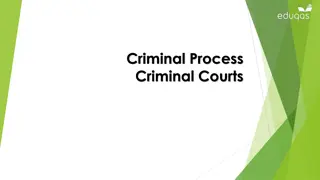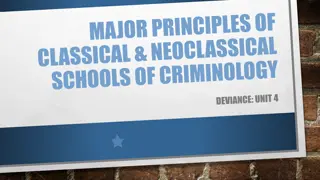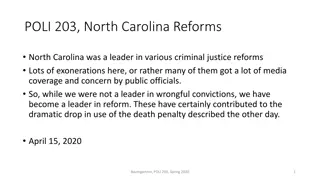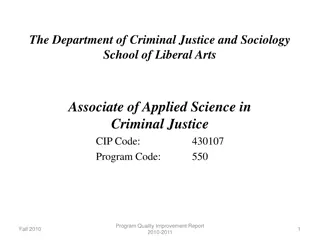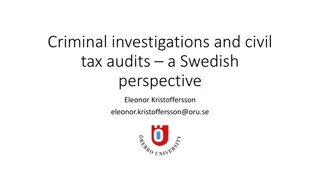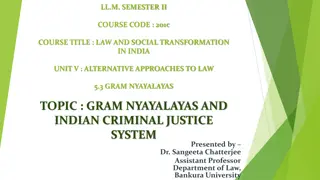Evolution of American Criminal Justice System
The American criminal justice system has evolved uniquely with decentralized structures at local, state, and federal levels. Lack of centralized policy coordination has made it susceptible to various influences, including partisan politics and reform movements. Over time, there have been shifts in power dynamics and processes at different governmental levels, shaping the system from the 19th century to the present day.
Download Presentation

Please find below an Image/Link to download the presentation.
The content on the website is provided AS IS for your information and personal use only. It may not be sold, licensed, or shared on other websites without obtaining consent from the author.If you encounter any issues during the download, it is possible that the publisher has removed the file from their server.
You are allowed to download the files provided on this website for personal or commercial use, subject to the condition that they are used lawfully. All files are the property of their respective owners.
The content on the website is provided AS IS for your information and personal use only. It may not be sold, licensed, or shared on other websites without obtaining consent from the author.
E N D
Presentation Transcript
AMERICAN CRIMINAL JUSTICE No criminal justice system: A distinctively American lack of centralized policy coordination
What developments and changes will effect crimes reported in press?
CRIMINAL JUSTICE, AMERICAN STYLE Across the nineteenth century, while other Western nation-states centralized their control over criminal justice, the United States did not. (Elizabeth Dale, Criminal Justice in the United States, 1789-1939, 36) In America, the public institutions of lawmaking bodies, police forces, prosecutors offices, courts, jails and prisons operate at the local, state and federal levels. The shifting boundaries of federalism rooted in the Constitution, legislation, and judicial rulings determine the scope of authority and power in each domain. This distinctively American lack of centralized policy coordination...leaves the nation s criminal justice institutions exceptionally vulnerable to the influences of partisan politics, reform movements, local customs and norms, and policymaking through litigation. (Michael Willrich, Criminal Justice in the United States, in The Cambridge History of Law in America, vol. III, 197)
THE BIG PICTURE The Narrative: State governments attempted to wrest power from local officials and communities and make criminal justice more formal and the federal government took an increasing interest in criminal justice, creating federal crimes, taking on increased policing and a role as guarantor of civil liberties and civil rights. The result was parallel and overlapping processes operating at local, state and federal levels. 1865-1900: State government vs. Popular Justice 1900-1920: Progressive Reform & Social Responsibility for Crime 1920-WW2: Crime Control WW2-1970s: The Liberal Moment 1970s to the present: The Severity Revolution
CRIMINAL JUSTICE IN 1865 Some progress in creating a formal system not in the control of local official and communities -- varied by region police forces rules of procedure modernized criminal laws crimes against property as well as the person published appellate opinions more control by lawyers and judges But popular forces gained ground even as courts became more centralized and formal Created parallel processes
JUSTICES OF THE PEACE Lower level remained local and informal, & dealt with lion s share of judicial business civil litigation involving modest sums workers seeking unpaid wages landlords and tenants suing each other collection agencies suing debtors wives prosecuting husbands for desertion parents suing children for being unruly or failing to bring home wages criminal cases of lesser grade about 96% of criminal caseload (only 4% held over for grand jury) vice, petty theft, assault fine (imprisoned to work off at 50c a day) = p.11 <Willrich?> typical justice had no legal training owned their office for length of their term collected most of his pay in fees he charged litigants and defendants for his services justice shops = swift and informal justice ordinary people often filed own complaints and argued own cases court held in homes or places of business = carpentry shops, dry goods stores, barns NOT justice remote from rest of litigants lives
JUSTICE OF THE PEACE MONTOYO HEARS A MINOR CASE, TAOS COUNTY, NM (1941) https://catalog.archives.gov/id/5220 02
REGIONAL VARIATION North: Criminal justice defined by DA s offices, criminal trial courts, urban police forces All part of local government All headed by, composed of, or subject to politicians South (prior to Civil War): Criminal justice defined by Courts, Masters, and Mobs Masters: privatized justice system, brutal and casual, with attention to anything recognizable as legal procedure Mobs: Slave Patrols of poor whites & vigilante justice, with lynchings of blacks & poor whites
CRIMINAL JUSTICE 1865-1900 Centralization New state laws regulating vice, sex, gambling, drugs New federal crimes: polygamy, obscenity, lotteries Professionalization of Police uniforms crime control not social service Persistent corruption: the Lexow Committee (1894) Formalize & Restrict Juries Coroners & Juries replaced with medical examiners Reduced powers for grand juries Juries decide only facts not law Increased plea bargaining BUT juries continue to decide law
POLICING: CRIME CONTROL & SOCIAL SERVICE Miscellaneous character of work of Boston police, 1887 30,681 arrests 1472 accidents 2,461 buildings found open and unsecured, 37 dangerous chimneys 169 dead bodies cared for 181 defective cesspools reports 66 defective drains 138 defective hydrants 2611 defective lamps 4 defective sewers 13,614 defective streets and walks 148 intoxicated persons assisted 1,572 lost children found, 269 insane persons taken in charge 28 missing persons reported151 missing persons found 7 rescued from drowning 1,673 sick and injured assisted 311 stray teams (of horses) found, 51,302 street obstructions removed
CRIMINAL JUSTICE 1865-1900 Centralization New state laws regulating vice, sex, gambling, drugs New federal crimes: polygamy, obscenity, lotteries Professionalization of Police uniforms crime control not social service Persistent corruption: the Lexow Committee (1894) Formalize & Restrict Juries Coroners & Juries replaced with medical examiners Reduced powers for grand juries Juries decide only facts not law Increased plea bargaining BUT juries continue to decide law
POPULAR JUSTICE Rough Justice: Lynching 80% of victims black; happened everywhere but New England Not in the legal system because it was too slow, unjust, failed Other mob actions: censure from churches; burn factories; women raiding saloons Polite Justice: Citizen s Groups Target theaters for obscenity, venues for drinking, crimes against children Rely on police for arrests but also made citizens arrests
POPULAR JUSTICE Rough Justice: Lynching 80% of victims black; happened everywhere but New England Not in the legal system because it was too slow, unjust, failed Other mob actions: censure from churches; burn factories; women raiding saloons Polite Justice: Citizen s Groups Target theaters for obscenity, venues for drinking, crimes against children Rely on police for arrests but also made citizens arrests
REGIONAL VARIATION North Large urban police forces Small inmate populations Relatively low levels of criminal violence South Smaller police and more mobs Larger prison populations heavy use of convict labor More crime West Like South initially but mob as substitute for absent system not supplement to it As grew more populous, became like north: vigilantism and crime declined



